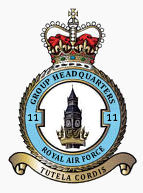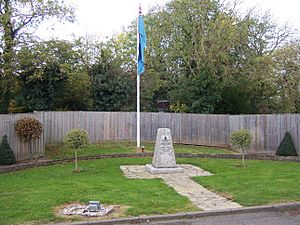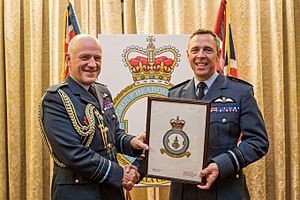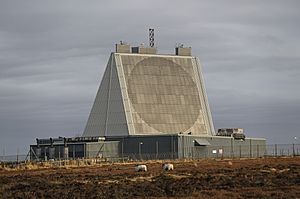No. 11 Group RAF facts for kids
Quick facts for kids No. 11 Group RAF |
|
|---|---|

No. 11 Group badge
|
|
| Active | 1 Apr – 17 May 1918 22 Aug 1918 – May 1920 1 May 1936 – 31 Dec 1960 1 Jan 1961 – 1 Apr 1963 1 Apr 1968 – 1 Apr 1996 1 Nov 2018 – present |
| Country | |
| Branch | |
| Type | Group headquarters |
| Role | Air and Space Command |
| Part of | RAF Air Command |
| Headquarters | Hillingdon House, Uxbridge (World War II) RAF High Wycombe |
| Motto(s) | Tutela cordis (Latin for 'Guardians of the heart') |
| Commanders | |
| Air Officer Commanding | Air Vice-Marshal Tom Burke |
| Notable commanders |
Air Vice-Marshal Keith Park |
| Insignia | |
| Group badge | Depicts the clock tower of the Palace of Westminster surrounded by an astral crown. The tower indicates London, the heart of the Empire, with whose safety the Group was charged during the Second World War. The hands of the clock are at 11 o'clock to represent the time of the Armistice of the First World War and the number of the Group. Awarded in 1940. |
No. 11 Group is a special unit in the Royal Air Force (RAF). It was first created way back in 1918. Over the years, it has been formed and then closed down several times. It was last closed in 1996 but started up again in 2018.
The group is most famous for its role in 1940 during the Battle of Britain. This was a huge air battle in World War II. No. 11 Group was in charge of defending London and the south-east of the United Kingdom from attacks by the German air force, known as the Luftwaffe. When it reformed in 2018, its new job was to help the RAF work better together across different areas, like air, space, and computers.
Contents
History of No. 11 Group
Early Years: World War I
No. 11 Group first started on April 1, 1918. Back then, it was called No. 11 (Equipment) Group. It was part of a larger RAF area. Just over a month later, on May 17, 1918, the group was closed down.
Between the World Wars
The group was brought back on August 22, 1918. It was part of the North-Western Area of the RAF. In May 1920, its status was changed, and it became No. 11 Wing, which is a smaller type of unit.
No. 11 Group was reformed again on May 1, 1936. This time, it was called No. 11 (Fighter) Group. Its main job was to defend the skies over southern England, including London. This made it the first RAF Fighter Command Group with this important role.
World War II: 1939 to 1945
During World War II, No. 11 Group used a special system called the Dowding system to control its fighter planes. The group's main office was at Hillingdon House in RAF Uxbridge, near London.
The most important part of their operations was in an underground room. This room is now famous as the Battle of Britain Bunker. From here, commands were sent to different airfields. Each airfield was in charge of several smaller airfields and fighter squadrons (groups of planes).
Here are some of the main sector airfields that No. 11 Group managed:
|
Sector A:
Sector B:
|
Sector C:
Sector D:
|
Sector E:
Sector F:
|
Sector Y:
Sector Z:
|

The Battle of Britain in 1940
The most famous time for No. 11 Group was during the Battle of Britain. They faced the strongest attacks from the German air force. Pilots who joined squadrons in No. 11 Group knew they would be fighting constantly. If pilots or squadrons were moved away from No. 11 Group, it meant they were going to a safer place.
During this battle, the group was led by Air vice-marshal Keith Park from New Zealand. He had support from other group commanders. However, the commander of 12 Group, Air Vice Marshal Trafford Leigh-Mallory, did not support him well. This caused problems for Park during a very important time. After the Battle of Britain, Leigh-Mallory worked with another officer to have Park removed from his job. Leigh-Mallory then took over command of No. 11 Group.
After World War II
After the war, in December 1951, No. 11 Group was made up of two main areas: the Southern and Metropolitan sectors. Many different squadrons were part of these sectors, flying various types of fighter planes.
In 1960, the RAF changed how Fighter Command was organized. No. 11 Group was closed on December 31, 1960, but it reopened just one day later! This happened when 13 Group was simply renamed No. 11 Group.
Later, on April 1, 1963, the group was replaced by a smaller unit called No. 11 (Northern) Sector. This sector controlled airfields in Northern England. On April 30, 1968, Fighter Command became part of a new unit called RAF Strike Command. No. 11 Group was reformed again as part of this new command. Its headquarters moved to RAF Bentley Priory in London. It became responsible for defending the entire UK Air Defence Region.
During this time, new and powerful fighter jets like the English Electric Lightning and the McDonnell Douglas F-4 Phantom II joined the RAF. In the early 1990s, No. 11 Group had many squadrons flying advanced jets like the Panavia Tornado ADV.
On April 1, 1996, No. 11 Group joined with 18 Group to form a new unit called 11/18 Group. Air Vice Marshal Anthony Bagnall was the last commander of No. 11 Group before this change.
Reformation in 2018
On July 11, 2018, the head of the RAF, Air Chief Marshal Sir Stephen Hillier, announced that No. 11 Group would be reformed. Its new purpose is to be a "multi-domain operations group." This means it will help the RAF connect and work together across different areas of warfare: in the air, in space, and in cyber-warfare (computer networks). The idea is to create a strong, connected force.
The group officially reformed at a ceremony on November 1, 2018. Air Vice-Marshal Ian Duguid took command at RAF High Wycombe.
Role and Operations Today
Today, No. 11 Group helps manage RAF operations. It includes the Joint Force Air Component (JFAC), which can be sent out to different locations. It also includes the National Air & Space Operations Centre (NASOC).
The group's main job is to make sure that all the information and data gathered helps with planning and carrying out operations in the air, space, and cyber worlds.
Stations
No. 11 Group is based at the NASOC, which is located at RAF High Wycombe. The group is also responsible for another important RAF station:
- RAF Spadeadam, Cumbria – This is where the UK practices its electronic warfare tactics.
List of Group Commanders
- 1936 to 1963
- 14 July 1936 Air Vice-Marshal Philip Joubert de la Ferté
- 7 September 1936 Air Vice-Marshal Leslie Gossage
- January 1940 Air Vice-Marshal William Welsh
- 20 April 1940 Air Vice-Marshal Keith Park
- 18 December 1940 Air Vice-Marshal Trafford Leigh-Mallory
- 28 November 1942 Air Vice-Marshal Hugh Saunders
- 1 November 1944 Air Vice-Marshal John Cole-Hamilton
- 20 July 1945 Air Vice-Marshal Dermot Boyle
- 24 April 1946 Air Vice-Marshal S D Macdonald
- 1 June 1948 Air Vice-Marshal Stanley Vincent
- 9 January 1950 Air Vice-Marshal Thomas Pike
- 5 July 1951 Air Vice-Marshal The Earl of Bandon
- 1 November 1953 Air Vice-Marshal Hubert Patch
- 16 January 1956 Air Vice-Marshal V S Bowling
- 12 January 1959 Air Vice-Marshal Alick Foord-Kelcey
- 1 January 1961 Air Vice-Marshal Harold Maguire
- 13 January 1962 Air Vice-Marshal Gareth Clayton
- 1968 to 1996
- 30 April 1968 Air Vice-Marshal R I Jones
- 2 February 1970 Air Vice-Marshal Ivor Broom
- 6 December 1972 Air Vice-Marshal Robert Freer
- 15 March 1975 Air Vice-Marshal William Harbison
- 14 March 1977 Air Vice-Marshal Donald Hall
- 3 September 1977 Air Vice-Marshal Peter Latham
- 7 January 1981 Air Vice-Marshal Peter Harding
- 11 August 1982 Air Vice-Marshal Kenneth Hayr
- 1 August 1985 Air Vice-Marshal Michael Stear
- 15 July 1987 Air Vice-Marshal Roger Palin
- 17 March 1989 Air Vice-Marshal Bill Wratten
- 16 September 1991 Air Vice-Marshal John Allison
- 15 July 1994 Air Vice-Marshal Anthony Bagnall
- 2018 to present
- 1 October 2018 Air Vice-Marshal Ian Duguid
- 1 December 2021 Air Vice-Marshal Philip Robinson
- 25 August 2023 Air Vice-Marshal Tom Burke
See also




